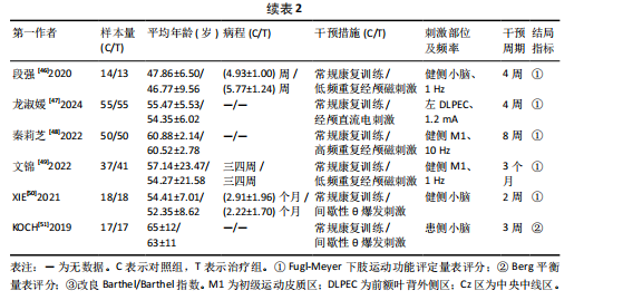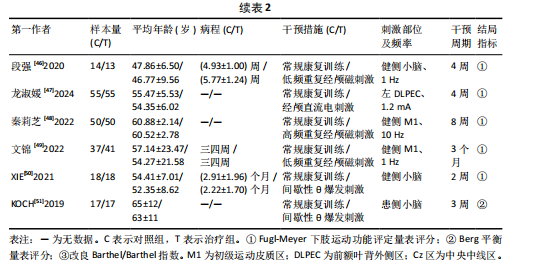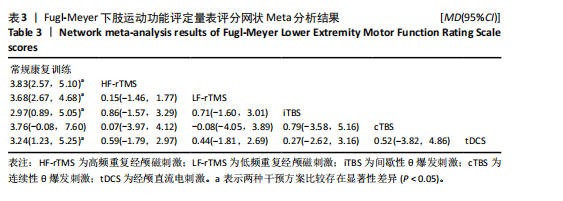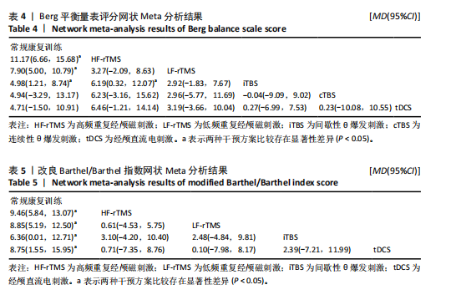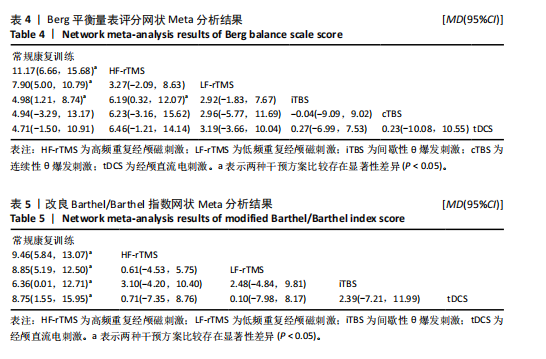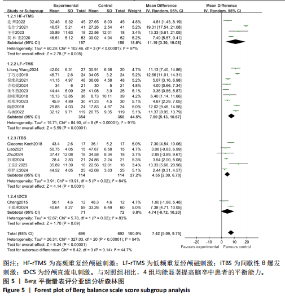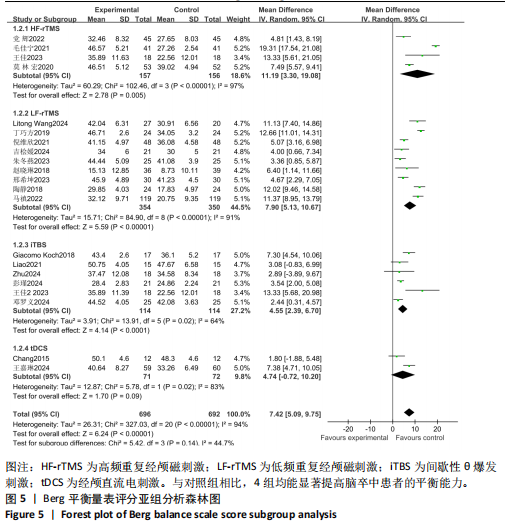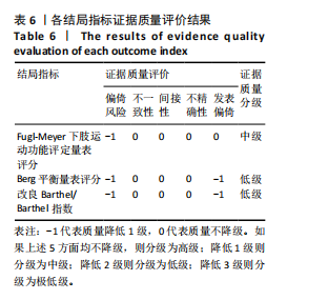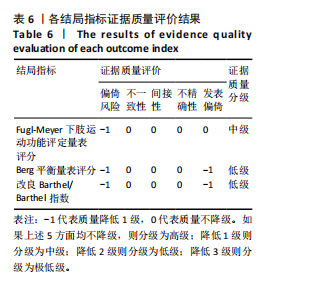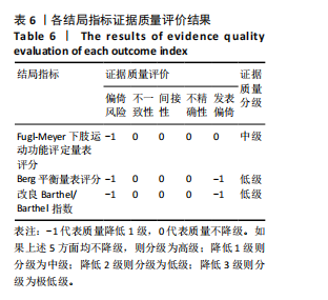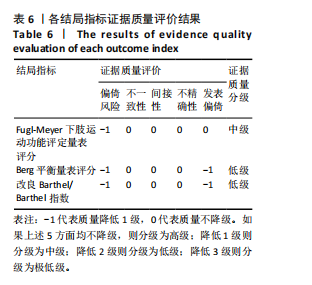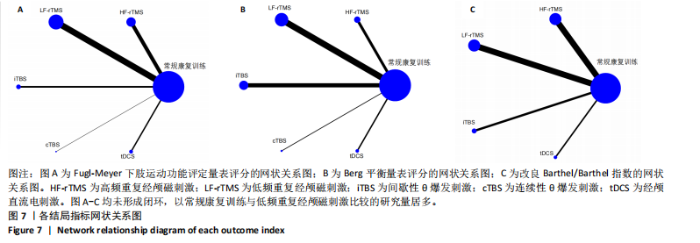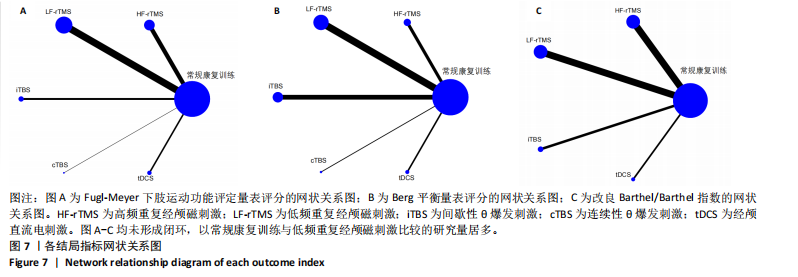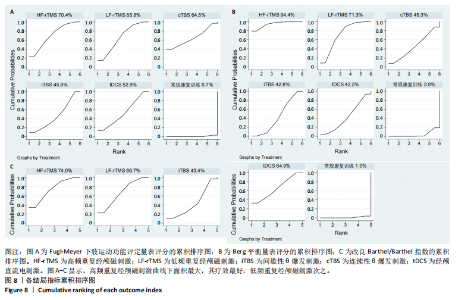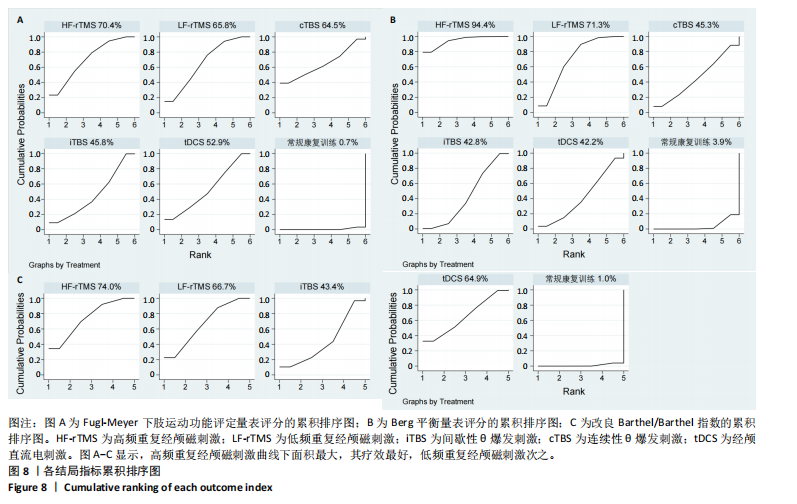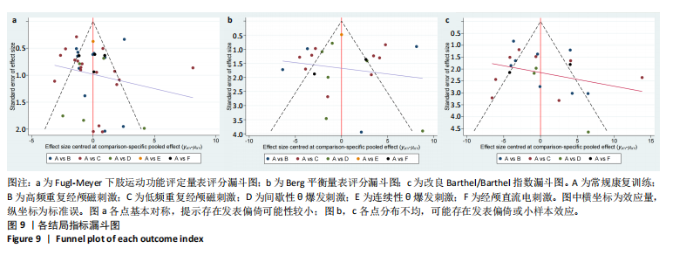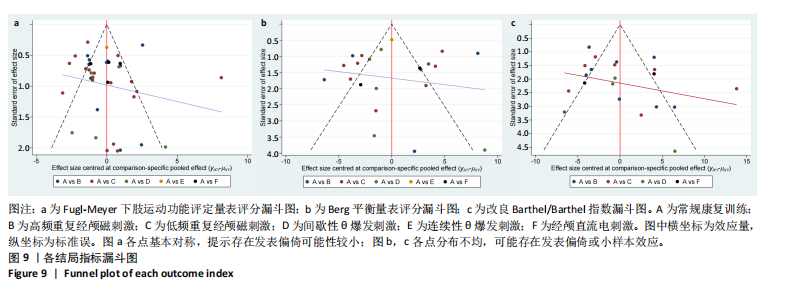Chinese Journal of Tissue Engineering Research ›› 2026, Vol. 30 ›› Issue (4): 1008-1018.doi: 10.12307/2025.967
Previous Articles Next Articles
Network meta-analysis of non-invasive brain stimulation in the treatment of lower limb motor dysfunction after stroke
Yang Yuanyuan, Zhou Shanshan, Cheng Xiaofei, Feng Luye, Tang Jiqin
- School of Rehabilitation Medicine, Shandong University of Traditional Chinese Medicine, Jinan 250355, Shandong Province, China
-
Received:2024-10-28Accepted:2024-12-20Online:2026-02-08Published:2025-05-22 -
Contact:Tang Jiqin, Associate professor, Master’s supervisor, School of Rehabilitation Medicine, Shandong University of Traditional Chinese Medicine, Jinan 250355, Shandong Province, China -
About author:Yang Yuanyuan, Master candidate, School of Rehabilitation Medicine, Shandong University of Traditional Chinese Medicine, Jinan 250355, Shandong Province, China -
Supported by:Scientific Research and Innovation Team Funded Project of Shandong University of Traditional Chinese Medicine, No. 220316 (to TJQ [project participant]); Shandong Geriatrics Society Fund, No. LKJGG2021Z018 (to TJQ); Shandong Province Traditional Chinese Medicine Science and Technology Development Program Project, No. 2017-011 (to TJQ)
CLC Number:
Cite this article
Yang Yuanyuan, Zhou Shanshan, Cheng Xiaofei, Feng Luye, Tang Jiqin. Network meta-analysis of non-invasive brain stimulation in the treatment of lower limb motor dysfunction after stroke[J]. Chinese Journal of Tissue Engineering Research, 2026, 30(4): 1008-1018.
share this article
Add to citation manager EndNote|Reference Manager|ProCite|BibTeX|RefWorks
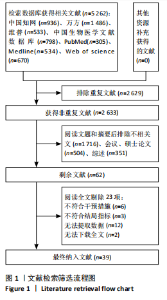
2.1 文献检索结果 经过各数据库检索,共获得5 262篇文献。采用文献管理软件NoteExpress,将2 629篇重复文献剔除,在初步阅读文章题目和摘要后剔除文献2 571篇,再浏览全文剔除23篇不符合纳排标准的文献,最终纳入39篇文献,见图1。 2.2 纳入文献的基本特征 此次研究纳入文献39篇[13-51],共2 920例研究对象,包括对照组1 440例、试验组1 480例。中文文献32篇,英文文献7篇,其中6篇为三臂试验[20,25,28,35,44,49],5篇为四臂试验[16,21,32,34,40],发表年份在2015-2024年间,涉及到6种干预措施,包括常规康复训练、高频重复经颅磁刺激、低频重复经颅磁刺激、间歇性θ爆发刺激、连续性θ爆发刺激、经颅直流电刺激。38篇报道了Fugl-Meyer下肢运动功能评定量表评分[13-50],21篇报道了Berg平"
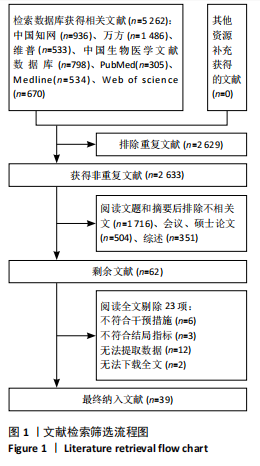
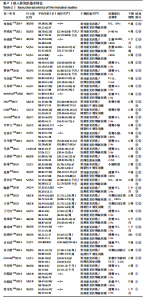
衡量表评分情况[23-42,51],22篇报道了改良Barthel/Barthel指数[13-34]。具体基本特征见表2。 2.3 纳入文献质量评价 所有文献均报道了随机方法[13-51],主要为随机数字表法(低风险),其中2篇文献提及按照治疗方法的不同分组(高风险)[30,49];7篇文献报道了隐藏分配[21-26,50],主要采用不透明信封进行(低风险);13篇文献报道了盲法的使用情况[22-30,42,44,50-51],其中6篇文献实施双盲(低风险)[22-24,42,50-51];所有随机对照试验均无缺失数据以及选择性的报告结果(低风险);其他偏倚情况无法判断(不明确)。最终所纳入文献的质量等级中4篇文献评为A[22-24,50],其余文献质量等级为B。偏倚风险评估结果见图2,3。 2.4 传统Meta分析结果 对所纳入文献做传统Meta分析,结果显示,Fugl-Meyer下肢运动功能评定量表评分(I2=87%)、Berg平衡量表评分(I2=94%)、改良Barthel/Barthel指数(I2=84%)3个结局指标中,总体异质性均较高,按照干预措施的不同做各结局指标的亚组分析,连续性θ爆发刺激组仅纳入1篇文献,因此未做亚组分析。亚组分析后发现各组间异质性"
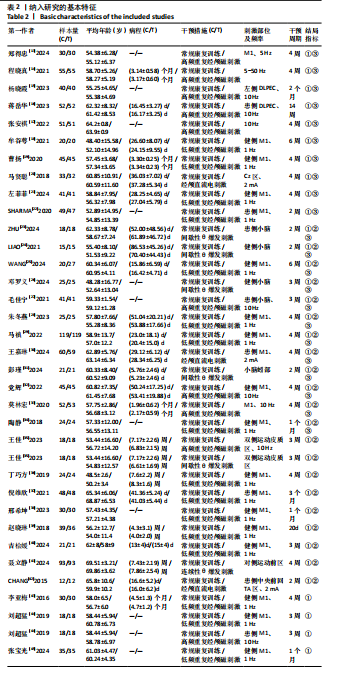

仍较高,遂采用随机效应模型进行分析,对结果仅做描述性分析。结果显示,高频重复经颅磁刺激、低频重复经颅磁刺激、间歇性θ爆发刺激、经颅直流电刺激与常规康复训练比较均能显著提高患者的Fugl-Meyer下肢运动功能评定量表评分、Berg平衡量表评分、改良Barthel/Barthel指数,改善脑卒中患者的下肢运动功能、平衡功能以及提高患者的日常生活活动能力,见图4-6。 2.5 网状Meta分析结果 2.5.1 网状关系图 如网状关系图所示,此次研究所有结局指标网状关系图均没有形成闭环(图7),图中以常规康复训练为中心,大致呈放射状结构;图中节点表示各干预措施总的样本量大小,此次研究以常规康复训练样本量以及低频重复经颅磁刺激总样本量居多;两节点之间的连线代表2个节点干预措施的直接比较,线段粗细表示研究数量的多少,此次研究以常规康复训练和低频重复经颅磁刺激以及常规康复训练和高频重复经颅磁刺激直接比较的研究量居多。 2.5.2 Fugl-Meyer下肢运动功能评定量表评分 纳入研究中有38篇文献报了Fugl-Meyer下肢运动功能评定量表评分[13-50],共6种干预措施,网状Meta结果显示,常规康复训练与高频重复经颅磁刺激[MD=3.83,95%CI(2.57,5.10)]、低频重复经颅磁刺激[MD=3.68,95%CI(2.67,4.68)]、间歇性θ爆发刺激[MD=2.97,95%CI(0.89,5.05)]、经颅直流电刺激[MD=3.24,95%CI(1.23,5.25)]比较差异有显著性意义(P < 0.05);常规康复训练与连续性θ爆发刺激[MD=3.76,95%CI(-0.08,7.60)]比较无统计学差异(P > 0.05),因此尚无明确证据表明,连续性θ爆发刺激在改善脑卒中患者下肢运动功能中优于常规康复训练;其余5种治疗措施间两两比较,结果显示差异均无显著性意义(P < 0.05),见表3。累积排序图结果显示第一为高频重复经颅磁刺激(70.4%),其次为低频重复经颅磁刺激(65.8%),后面各干预措施从大到小依次为连续性θ爆发刺激(64.5%)、经颅直流电刺激(52.9%)、间歇性θ爆发刺激(45.8%)、常规康复训练(0.7%),见图8A。"
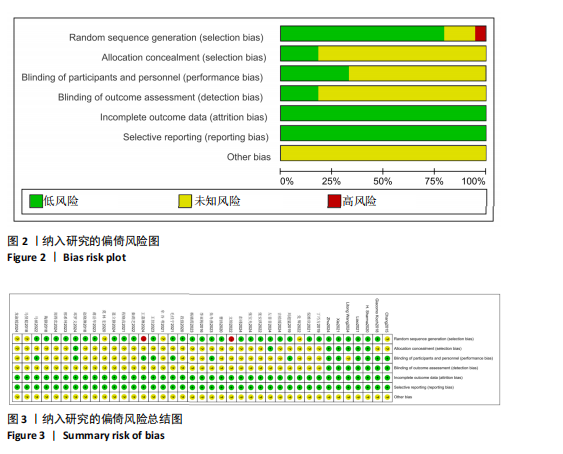
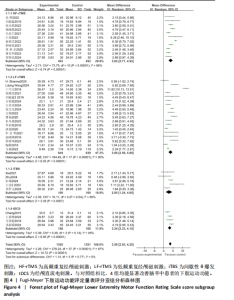
2.5.3 Berg平衡量表评分 纳入研究中有21篇文献报道了Berg平衡量表评分[23-42,51],共6种干预措施,网状Meta结果显示,常规康复训练与高频重复经颅磁刺激[MD=11.17,95%CI(6.66,15.68)]、低频重复经颅磁刺激[MD=7.90,95%CI(5.00,10.79)]、间歇性θ爆发刺激[MD=4.98,95%CI(1.21,8.74)]比较差异有显著性意义(P < 0.05);常规康复训练与连续性θ爆发刺激[MD=4.94,95%CI(-3.29,13.17)]、经颅直流电刺激[MD=4.71,95%CI(-1.50,10.91)]比较无统计学差异(P > 0.05),说明目前无明确证据表明,连续性θ爆发刺激与经颅直流电刺激在改善脑卒中患者下肢平衡功能方面优于常规康复训练;高频重复经颅磁刺激与间歇性θ爆发刺激[MD=6.19,95%CI(0.32,12.07)]比较差异有显著性意义(P < 0.05);其余治疗措施间两两比较无统计学差异(P > 0.05),见表4。累积排序图结果显示第一为高频重复经颅磁刺激(94.4%),其次为低频重复经颅磁刺激(71.3%),后面各干预措施从大到小依次为连续性θ爆发刺激(45.3%)、间歇性θ爆发刺激(42.8%)、经颅直流电刺激(42.2%)、常规康复训练(3.9%),见图8B。 2.5.4 改良Barthel/Barthel指数 纳入研究中有22篇文献报道了改良Barthel/Barthel指数[13-34],涉及5种干预措施,网状Meta结果显示,常规康复训练与高频重复经颅磁刺激[MD=9.46,95%CI(5.84,13.07)]、低频重复经颅磁刺激[MD=8.85,95%CI(5.19,12.50)]、间歇性θ爆发刺激[MD=6.36,95%CI(0.01,12.71)]、经颅直流电刺激[MD=8.75,95%CI (1.55,15.95)]比较差异有显著性意义(P < 0.05);其余治疗措施间比较无统计学差异(P > 0.05),见表5。累积排序图结果显示第一为高频重复经颅磁刺激(74.0%),其次为低频重复经颅磁刺激(66.7%),后面各干预措施从大到小依次为经颅直流电刺激(64.9%)、间歇性θ爆发刺激(43.4%)、常规康复训练(1.0%),见图8C。 2.6 发表偏倚 Fugl-Meyer下肢运动功能评定量表评分漏斗图显示各研究大致分布在垂直线的周围及两侧,表明出现发表偏倚的可能性较少;Berg平衡量表评分、改良Barthel/Barthel指数漏斗图大致散在分布,有些研究落在了漏斗图以外,提示可能存在发表偏倚或小样本效应,具体原因可能是大部分文献未设置盲法和分配隐藏等,研究结果解释需谨慎(图9)。 2.7 GRADE证据质量评价 通过分析各结局指标所纳入文献,可能由于多"
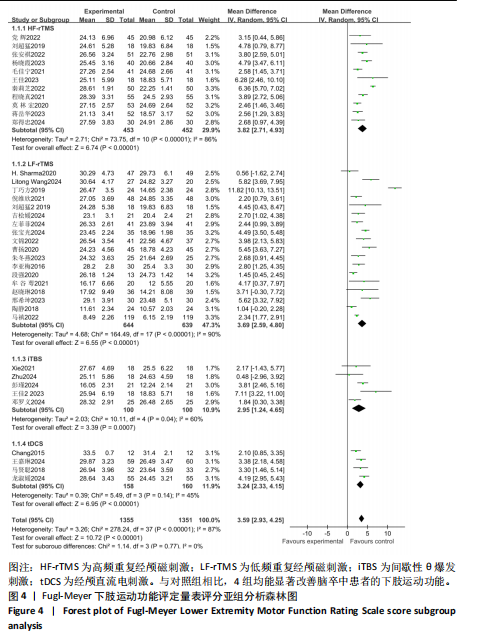
| [1] HUANG G, WANG H, ZHAO W, et al. Effects of the intermittent theta burst stimulation on gait, balance and lower limbs motor function in stroke: study protocol for a double-blind randomised controlled trial with multimodal neuroimaging assessments. BMJ Open. 2024;14(8):e082019. [2] GBD 2019 Stroke Collaborators. Global, regional, and national burden of stroke and its risk factors, 1990-2019: a systematic analysis for the Global Burden of Disease Study 2019. Lancet Neurol. 2021;20(10):795-820. [3] 单莎瑞,黄旭明,张明兴,等. 三维步态分析低频重复经颅磁刺激治疗脑卒中后偏瘫的步态变化[J].中国组织工程研究, 2022,26(5):762-767. [4] CAMBIAGHI M, CORDARO M, DOSSENA S, et al. Editorial: non-invasive brain stimulation techniques in neurological and neuropsychiatric disorders: physiological and molecular evidence. Front Syst Neurosci. 2023;17:1128205. [5] 吴思杏,纪运,马柯.不同模式经颅磁刺激治疗神经病理性疼痛的研究进展[J].中国疼痛医学杂志,2024,30(8):563-567. [6] 胡填,王陶陶,古剑雄,等.重复经颅磁刺激治疗脑卒中后下肢运动功能障碍疗效的Meta分析[J].实用心脑肺血管病杂志,2022,30(9):80-87. [7] BERETTA VS, SANTOS PCR, ORCIOLI-SILVA D, et al. Transcranial direct current stimulation for balance rehabilitation in neurological disorders: A systematic review and meta-analysis. Ageing Res Rev. 2022;81:101736. [8] 各类脑血管疾病诊断要点[J].中华神经科杂志,1996(6):60-61. [9] 中华医学会神经病学分会,中华医学会神经病学分会脑血管病学组.中国各类主要脑血管病诊断要点2019[J].中华神经科杂志,2019,52(9):710-715. [10] BRÄMER GR. International statistical classification of diseases and related health problems. Tenth revision. World Health Stat Q. 1988;41(1):32-36. [11] HIGGINS JP, GREEN S. Cochrane handbook for systematic reviews of intervention version 5.1.0. [2016-05-10]. http://handbook.cochrane.org/.pdf. [12] 王琪,王建成,潘蓓,等. 网状Meta分析证据质量分级:GRADE方法学前沿与进展[J].中国循证医学杂志,2020,20(8): 979-985. [13] 郑得忠,林玮佳,李梦丹. rTMS疗法在缺血性脑卒中康复治疗中的应用及对认知功能的影响[J].中外医疗,2024,43(18): 66-68+72. [14] 程晓真,牛延峰. 重复经颅磁刺激联合康复训练对脑卒中患者认知和肢体运动功能的影响[J].河南医学研究,2021,30(36): 6763-6766. [15] 杨晓霞. 重复经颅磁刺激技术联合常规康复训练对脑卒中偏瘫患者肢体运动功能、日常生活能力及生存质量的影响[J].反射疗法与康复医学,2023,4(9):92-95. [16] 蒋岳华,赵行,郭平. 经颅磁刺激治疗联合时间康复管理在缺血性脑卒中后偏瘫中的应用效果[J].河南医学研究,2023, 32(12):2154-2158. [17] 张安祺. 高频重复经颅磁刺激结合运动康复治疗对脑梗死后康复期患者运动功能及脑循环动力学的影响[J].世界最新医学信息文摘, 2022,22(49):50-53,103. [18] 牟谷萼,刘瑶杰,阮智利,等. 低频rTMS对恢复早期脑卒中患者下肢运动功能的影响 [J].中国康复,2021,36(8):465-468. [19] 曹扬,李丹. 重复经颅磁刺激对脑梗死患者下肢运动功能的影响及可行性分析[J].大医生,2020,5(24):24-26. [20] 马贤聪,鲍晓,杨泉,等. 抗阻运动联合经颅直流电刺激对脑卒中偏瘫患者肢体运动功能的影响[J].临床与病理杂志, 2018,38(4):805-811. [21] 左菲菲,成旭东,王帆,等. 重复经颅磁刺激联合分级运动想象训练对脑梗死后偏瘫患者运动功能及神经功能的影响[J].中国临床实用医学,2024,15(3):44-50. [22] SHARMA H, VISHNU VY, KUMAR N, et al. Efficacy of Low-Frequency Repetitive Transcranial Magnetic Stimulation in Ischemic Stroke: A Double-Blind Randomized Controlled Trial. Arch Rehabil Res Clin Transl. 2020;2(1):100039. [23] ZHU PA, LI ZL, LU QQ, et al. Can cerebellar theta-burst stimulation improve balance function and gait in stroke patients? A randomized controlled trial. Eur J Phys Rehabil Med. 2024;60(3):391-399. [24] LIAO LY, XIE YJ, CHEN Y, et al. Cerebellar Theta-Burst Stimulation Combined With Physiotherapy in Subacute and Chronic Stroke Patients: A Pilot Randomized Controlled Trial. Neurorehabil Neural Repair. 2021;35(1):23-32. [25] WANG L, WANG L, WANG Z, et al. Clinical Effect Analysis of Wearable Sensor Technology-Based Gait Function Analysis in Post-Transcranial Magnetic Stimulation Stroke Patients. Sensors (Basel). 2024;24(10):3051. [26] 邓罗义,陈彦,曾妮,等. 健侧小脑间歇性θ短阵脉冲刺激康复治疗对脑卒中患者下肢步行功能的影响[J].实用医学杂志,2024,40(13):1797-1802. [27] 毛佳宁,崔利华,常玲,等. 小脑重复经颅磁刺激对脑卒中患者平衡功能的影响分析[J].反射疗法与康复医学,2021, 2(4):146-149. [28] 朱冬燕,卢红建,黄志东,等. 重复经颅磁刺激联合改良强制性运动疗法对脑卒中患者步行功能的影响[J].中华物理医学与康复杂志,2023,45(9):781-785. [29] 马禛,陈万强,张鑫,等. 重复经颅磁刺激对脑卒中患者平衡功能的影响[J].中华物理医学与康复杂志, 2022,44(8):703-706. [30] 王嘉琳,刘立芝,官艳林,等. 经颅直流电刺激联合运动康复训练对脑卒中患者下肢运动功能和血清Hcy水平的影响[J].川北医学院学报,2024,39(1):34-37. [31] 彭瑾,谢珊,查益,等. 间歇性θ短阵脉冲刺激小脑蚓部对脑卒中患者下肢运动功能障碍的影响[J].神经损伤与功能重建,2025,20(1):21-25. [32] 党辉,李彩霞,吴清俊,等. 重复经颅磁刺激结合穴位肌电生物反馈治疗对脑卒中患者胫骨前肌形态结构与肌力的影响[J].中国实用神经疾病杂志,2022,25(10): 1236-1244. [33] 莫林宏,刘爱贤. 经颅磁刺激联合康复功能训练对脑卒中后偏瘫病人步态、平衡能力及FMA评分的影响[J].中西医结合心脑血管病杂志,2020,18(23):4065-4068. [34] 陶静,魏雁. 重复经颅磁刺激联合重复注射A型肉毒毒素对脑卒中后下肢肌肉痉挛状态的临床疗效和安全性研究[J].脑与神经疾病杂志,2018,26(5):272-276. [35] 王佳,王先斌,宋宁,等. 不同经颅磁刺激模式对脑卒中后下肢运动障碍患者肢体运动功能的影响[J].贵州医科大学学报,2023,48(6):702-709. [36] 丁巧方,李哲,李锐,等. 低频重复经颅磁刺激对脑卒中偏瘫患者下肢肌张力、运动功能及步行能力的影响[J].中国实用医刊,2019,46(4):4-8. [37] 倪维欣,王宇轩,李晓雯. 早期康复训练联合低频重复经颅磁刺激对脑卒中后偏瘫患者平衡能力及肢体运动功能的影响[J].反射疗法与康复医学,2021,2(7):161-163,171. [38] 邢希坤. 重复经颅磁刺激对脑卒中患者平衡及步行功能的影响分析[J].健康之友,2023(8):158-160. [39] 赵晓琳,刘天龙,周禹鑫,等. 重复经颅磁刺激对脑卒中患者运动功能障碍的影响[J].中国康复医学杂志,2018,33(7):800-805. [40] 吉桧媛,朱冬燕,王梁,等. 重复经颅磁刺激联合机器人辅助步态训练对缺血性卒中患者下肢功能的影响[J].中国脑血管病杂志,2024,21(4):227-235. [41] 聂立静,邓倩,张辉芳. 连续θ爆发经颅磁刺激对侧运动前区对脑卒中重度偏瘫患者痉挛步态的影响[J].中华老年心脑血管病杂志,2024,26(9):1044-1048. [42] CHANG MC, KIM DY, PARK DH. Enhancement of Cortical Excitability and Lower Limb Motor Function in Patients With Stroke by Transcranial Direct Current Stimulation. Brain Stimul. 2015;8(3):561-566. [43] 李亚梅,黄林,张晶,等. 重复经颅磁刺激对脑梗死患者下肢运动功能的影响[J].中华物理医学与康复杂志,2016,38(11): 839-842. [44] 刘超猛,孟瑶,李浩浩,等. 重复经颅磁刺激对缺血性脑卒中患者运动功能和血清MMP-9、hs-CRP的影响[J].天津医药, 2019,47(2):184-188. [45] 张宝光. 重复经颅磁刺激联合康复训练治疗急性脑梗死患者的效果[J].反射疗法与康复医学,2024,5(16):52-55. [46] 段强,孙良文,韦春霞,等. 作用于小脑的低频rTMS对后循环缺血卒中患者的下肢运动功能及皮层兴奋性的影响[J].中华脑科疾病与康复杂志(电子版),2020, 10(6):352-356. [47] 龙淑媛,叶经香,王桂瑜. 左背外侧前额叶阳极经颅直流电刺激联合康复训练对脑卒中后肢体运动障碍患者的心理和运动功能的影响[J].国际精神病学杂志, 2024,51(4):1230-1232+1236. [48] 秦莉芝,冯汝恩. 对脑卒中并发下肢运动功能障碍患者开展重复经颅磁刺激结合康复训练的效果[J].现代医学与健康研究电子杂志,2022,6(19):4-7. [49] 文锦,陈南萍. 低频rTMS结合外周磁刺激对脑梗死患者下肢功能障碍影响临床研究[J].实用中西医结合临床,2022, 22(2):36-39. [50] XIE YJ, WEI QC, CHEN Y, et al. Cerebellar Theta Burst Stimulation on Walking Function in Stroke Patients: A Randomized Clinical Trial. Front Neurosci. 2021;15:688569. [51] KOCH G, BONNÌ S, CASULA EP, et al. Effect of Cerebellar Stimulation on Gait and Balance Recovery in Patients With Hemiparetic Stroke: A Randomized Clinical Trial. JAMA Neurol. 2019;76(2):170-178. [52] CHEN Y, YANG L, LI X, et al. Non-invasive brain stimulation for limb motor function and daily living activity improvement in acute stroke: A meta-analysis. J Stroke Cerebrovasc Dis. 2023;32(4):106982. [53] SAFDAR A, SMITH MC, BYBLOW WD, et al. Applications of Repetitive Transcranial Magnetic Stimulation to Improve Upper Limb Motor Performance After Stroke: A Systematic Review. Neurorehabil Neural Repair. 2023;37(11-12):837-849. [54] 俞风云,朱玉连,王卫宁,等.经颅磁刺激在脑卒中患者中的应用及机制研究进展[J].中国康复医学杂志,2021,36(8):1030-1034. [55] DI PINO G, PELLEGRINO G, ASSENZA G, et al. Modulation of brain plasticity in stroke: a novel model for neurorehabilitation. Nat Rev Neurol. 2014;10(10):597-608. [56] NTAKOU EA, NASIOS G, NOUSIA A, et al. Targeting Cerebellum with Non-Invasive Transcranial Magnetic or Current Stimulation after Cerebral Hemispheric Stroke-Insights for Corticocerebellar Network Reorganization: A Comprehensive Review. Healthcare (Basel). 2022;10(12):2401. [57] ELSNER B, KWAKKEL G, KUGLER J, et al. Transcranial direct current stimulation (tDCS) for improving capacity in activities and arm function after stroke: a network meta-analysis of randomised controlled trials. J Neuroeng Rehabil. 2017;14(1):95. [58] 汤子寒,李加加,加健,等. 经颅磁改善脑卒中患者下肢运动功能和日常生活能力的Meta分析[J].湖北民族大学学报(医学版),2021,38(1):35-40. [59] 陈桐彬,王佩佩,林晓燕,等. 不同模式重复经颅磁刺激对脑卒中后认知障碍患者疗效的meta分析[J].中国康复医学杂志,2024,39(10):1519-1526. [60] 罗红,徐丽.重复经颅磁刺激联合重复外周磁刺激对脑出血患者上肢运动功能的效果:基于静息态功能磁共振成像的随机对照试验[J].中国康复理论与实践, 2024,30(9):1060-1068. [61] GUAN YZ, LI J, ZHANG XW, et al. Effectiveness of repetitive transcranial magnetic stimulation (rTMS) after acute stroke: A one-year longitudinal randomized trial. CNS Neurosci Ther. 2017;23(12):940-946. [62] SHAO Y, YANG Y, SUN YX, et al. Different frequencies of repetitive transcranial magnetic stimulation combined with local injection of botulinum toxin type A for post-stroke lower limb spasticity: study protocol for a prospective, single-center, non-randomized, controlled clinical trial. Neural Regen Res. 2022;17(11):2491-2496. [63] ZHANG W, LI W, LIU X, et al. Examining the effectiveness of motor imagery combined with non-invasive brain stimulation for upper limb recovery in stroke patients: a systematic review and meta-analysis of randomized clinical trials. J Neuroeng Rehabil. 2024;21(1):209. [64] CHEN Y, SU W, GUI CF, et al. Effectiveness of cerebellar vermis intermittent theta-burst stimulation in improving trunk control and balance function for patients with subacute stroke: a randomised controlled trial protocol. BMJ Open. 2023;13(1):e066356. [65] RANJAN S, REZAEE Z, DUTTA A, et al. Feasibility of Cerebellar Transcranial Direct Current Stimulation to Facilitate Goal-Directed Weight Shifting in Chronic Post-Stroke Hemiplegics. IEEE Trans Neural Syst Rehabil Eng. 2021;29:2203-2210. [66] ZHOU J, CHEN Y, GIN T, et al. The Effects of Repetitive Transcranial Magnetic Stimulation on Standing Balance and Walking in Older Adults with Age-related Neurological Disorders: A Systematic Review and Meta-analysis. J Gerontol A Biol Sci Med Sci. 2023; 78(5):842-852. [67] 刘佳,李岩,顾旭东,等. 高频重复经颅磁刺激联合姿势控制训练对脑卒中患者下肢运动功能的影响[J].中国康复医学杂志, 2024,39(2):263-265. [68] VELDEMA J, GHARABAGHI A. Non-invasive brain stimulation for improving gait, balance, and lower limbs motor function in stroke. J Neuroeng Rehabil. 2022;19(1):84. [69] WANG Q, ZHANG D, ZHAO YY, et al. Effects of high-frequency repetitive transcranial magnetic stimulation over the contralesional motor cortex on motor recovery in severe hemiplegic stroke: A randomized clinical trial. Brain Stimul. 2020;13(4):979-986. |
| [1] | Zheng Yin, Wu Zhenhua, Zhang Cheng, Ruan Kexin, Gang Xiaolin, Ji Hong. Safety and efficacy of immunoadsorption therapy for rheumatoid arthritis: a network meta-analysis and systematic review [J]. Chinese Journal of Tissue Engineering Research, 2026, 30(5): 1260-1268. |
| [2] | Leng Xiaoxuan, Zhao Yuxin, Liu Xihua. Effects of different neuromodulatory stimulation modalities on non-motor symptoms in Parkinson’s patients: a network meta-analysis [J]. Chinese Journal of Tissue Engineering Research, 2026, 30(5): 1282-1293. |
| [3] | Zhang Xinxin, Gao Ke, Xie Shidong, Tuo Haowen, Jing Feiyue, Liu Weiguo. Network meta-analysis of non-surgical treatments for foot and ankle ability and dynamic balance in patients with chronic ankle instability [J]. Chinese Journal of Tissue Engineering Research, 2025, 29(9): 1931-1944. |
| [4] | Wang Juan, Wang Guanglan, Zuo Huiwu. Efficacy of exercise therapy in the treatment of anterior cruciate ligament reconstruction patients: #br# a network meta-analysis #br# [J]. Chinese Journal of Tissue Engineering Research, 2025, 29(8): 1714-1726. |
| [5] | Li Zhe, Li Ping, Zhang Chao, Guo Guangling. A network meta-analysis of efficacy of mesenchymal stem cells from different sources in treatment of premature ovarian failure animal models [J]. Chinese Journal of Tissue Engineering Research, 2025, 29(36): 7898-7908. |
| [6] | Tian Jinxin, Zhao Yuxin, Hu Tong, Cui Tiantian, Ma Lihong. Effects of different transcranial magnetic stimulation modes on refractory depression in adults: a network meta-analysis [J]. Chinese Journal of Tissue Engineering Research, 2025, 29(35): 7639-7648. |
| [7] | Wang Kaigang, Hao Dongsheng, Ma Pei, Zhou Shuo, Li Ruimin. Comparison of efficacy of different biological scaffolds for pulp regeneration therapy in immature permanent teeth: a Bayesian network meta-analysis [J]. Chinese Journal of Tissue Engineering Research, 2025, 29(34): 7447-7460. |
| [8] | Wang He, Yu Shaohong, . Meta-analysis of transcranial direct current stimulation in improving lower limb motor dysfunction in stroke patients [J]. Chinese Journal of Tissue Engineering Research, 2025, 29(30): 6556-6565. |
| [9] | Li Jia, Liu Qianru, Xing Mengnan, Chen Bo, Jiao Wei, Meng Zhaoxiang. A network meta-analysis on therapeutic effect of different types of exercise on knee osteoarthritis patients [J]. Chinese Journal of Tissue Engineering Research, 2025, 29(3): 609-616. |
| [10] | Deng Yiran, Wang Xianliang, Li Dandan. Meta-analysis of exercise intervention on cardiopulmonary function in stroke patients [J]. Chinese Journal of Tissue Engineering Research, 2025, 29(24): 5203-5211. |
| [11] | Zhao Yuxin, Zhang Deqi, Bi Hongyan. Effect of different stimulation modalities of non-invasive brain stimulation on cognitive function in patients with Parkinson’s disease: a network Meta-analysis [J]. Chinese Journal of Tissue Engineering Research, 2025, 29(24): 5212-5223. |
| [12] | Hu Tong, Li Xuan, Yuan Jing, Wang Wei. Different electromagnetic stimulation programs improve post-stroke dysphagia: a network Meta-analysis [J]. Chinese Journal of Tissue Engineering Research, 2025, 29(24): 5224-5236. |
| [13] | Liu Xingzhao, Hu Tong, Ma Yan, Wang Qian, Wei Xiaohui, Chang Wanpeng, Yu Shaohong. Efficacy of rehabilitation robots on lower limb motor function in patients with cerebral palsy: a Meta-analysis [J]. Chinese Journal of Tissue Engineering Research, 2025, 29(18): 3925-3933. |
| [14] | Wang Ke, Wang Lei, Li Wenshan, Gong Weijun . Application prospect of brain-computer interface technology in the rehabilitation of lower limb function in stroke patients [J]. Chinese Journal of Tissue Engineering Research, 2025, 29(14): 3027-3033. |
| [15] | Zhong Jun, Wang Wen. Network meta-analysis of different anatomical repair strategies to improve chronic lateral ankle instability [J]. Chinese Journal of Tissue Engineering Research, 2024, 28(9): 1470-1476. |
| Viewed | ||||||
|
Full text |
|
|||||
|
Abstract |
|
|||||
